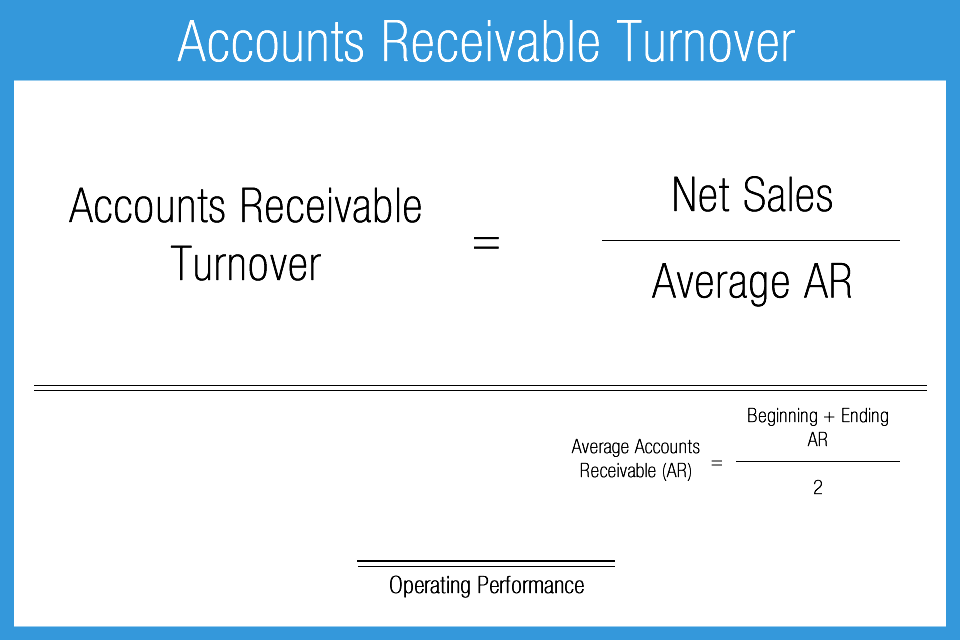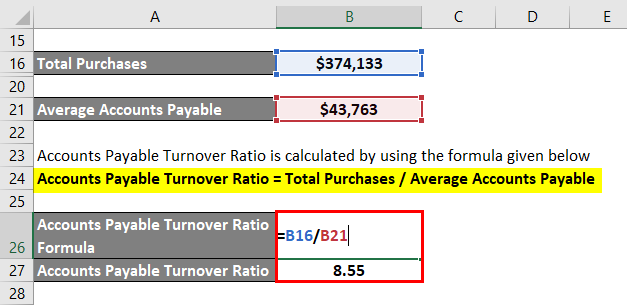
may be attempting to fund its operations by stretching its payment periods. As this falls below the preferred threshold of six times a year, it could be a sign that ABC Co. pays its suppliers an average of five times a year, or once every 73 days. calculates its payables turnover based on the information contained in its income statement and balance sheet: Anything below six is considered a sign that a business is stretching its payable periods to fund its operations. While a healthy payable turnover rate varies by industry, companies should typically maintain a rate of between eight and 10. Payables turnover = total supplier purchases / average accounts payable Payables turnover is calculated as follows: The calculation of the accounts receivable turnover ratio is: credit sales for a year divided by the companys average amount of accounts receivable. It is one of six main calculations used to determine short-term liquidity-the ability of a company to pay its bills as they come due. Payables turnover shows how many times a year a company pays its suppliers. Growth & Transition Capital financing solutions Kauffman Fellows Program Partial Scholarship Venture Capital Catalyst Initiative (VCCI) However, COGS of the company must also be checked to ensure that more payment period is not being passed off as high price to the firm.Industrial, Clean and Energy Technology (ICE) Venture Fund A lower accounts payable ratio entails that the firm has the bargaining power which allows it to pay its vendor late. Bargaining power once again has a big role to play in the accounts payable ratio.
#PAYABLE TURNOVER RATIO FORMULA FREE#
Here the objective is to delay payments as much as possible and utilize this free source of funds to finance the firms own business short term. Where: Net credit sales are sales where the cash is collected at a later date. The accounts receivable turnover ratio formula is as follows: Accounts Receivable Turnover Ratio Net Credit Sales / Average Accounts Receivable. In that case the objective was to receive payments as soon as possible. Accounts Receivable Turnover Ratio Formula. The accounts payable turnover ratio can be considered to be the exact inverse of the accounts receivable turnover ratio. Therefore in 360 days, the receivables are turned over (360 / 144) 2.5 times. This means that the old bills are replaced a new set of bills every 144 days. The firm therefore pays its bills every 144 days on an average. *For the purpose of calculation of ratios accountants assume that the year has 360 days.

Number of Days Receivables Outstanding = (40 / 100) * 360
#PAYABLE TURNOVER RATIO FORMULA HOW TO#
This article lays out what accounts payable turnover is, how to measure it, and why today’s metric-savvy accounting teams keep such a close eye on it. It measures how quickly a business makes payments to creditors and suppliers. The calculation of number of days outstanding ratio therefore is as follows: A company's accounts payable turnover rate is a a key measure of back-office efficiency and financial health. However in this case we shall consider the accounts payables to be 40% of all credit purchases Number of Days Outstanding Ratio Calculate the following efficiency ratios: a) Accounts Payable Turnover Ratio. Parag Patel Published on JanuPut simply, a companys A/P turnover tracks how quickly a business pays its creditors. Hence we can use the same example to understand the calculation of this ratio as well.

The calculation of this ratio is just like the calculation of accounts receivable turnover ratio. This formula converted to a percentage shows the average amount of payables that are outstanding. The formula for the A/P turnover ratio is annual cost of goods sold divided by average accounts payable: In the example below, to calculate A/P turnover. The FormulaĪccounts Payable Turnover Ratio = Net Credit Purchase / Average Accounts Payables *Īverage Accounts Payables = (Beginning Accounts Payables + Ending Accounts Payables) / 2 In that case, the firm may be better off using its own money to buy products at a lower price from vendors that charge a lower price. However, due care must be taken that vendors are not passing off the finance charges in the form of higher prices for products purchased. By doing so, they are using the vendors money to temporarily finance their own business without any cost attached. Since there are no interest charges involved and this is purely trade credit, the objective of the firm ideally should be to pay its bills as late as possible. Just like accounts receivable turnover ratio show the financing that the firm is providing to its buyers interest free, the accounts payable turnover ratio show the financing that the firm is able to receive from its vendors and suppliers free of cost.


 0 kommentar(er)
0 kommentar(er)
